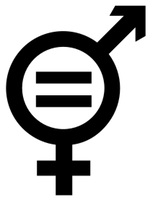Where am I?
Home -> The Evolution of Alice Criticism -> Feminist Criticism
 The Feminist Approach
The Feminist Approach
“Alice’s two dream adventures are almost a comic compendium of feminist issues.”
– Judith Little
What is a Feminist Critical Approach?
Feminist criticism is an often misunderstood branch of literary theory which is rather difficult to summarize. Lois Tyson gives this “bare bones” definition:
“Feminist criticism examines the ways in which literature (and other cultural productions) reinforces or undermines the economic, political, social and psychological oppression of women.” (83)
Feminist critics incorporate many other literary schools (historical, psychoanalytic, etc) to “increase our understanding of women’s experience, both in the past and present, and promote our appreciation of women’s value in the world” (119). They are extremely wide-ranging in scope, interest, topics, and conclusions. The practice of feminist criticism usually entails examining how the gender roles of a work of literature reflect or subvert “traditional” gender roles.
Feminism and Alice
Alice is an interesting case study for feminist critics. For, although written by a man during the Victorian Era, the book’s strong female heroine and her adventures are a veritable gold mine for feminist critics to study. In fact, Judith Little even wrote that the Alice books are “almost a comic compendium of feminist issues” (195).
Alice the Rebel
There are two main ways to approach Alice. Either critics have seen her as a feminist hero, a rebel breaking out of the traditional female gender roles, or they are more hesitant to give Carroll the credit of really breaking any stereotypes. Judith Little and Megan S. Lloyd are both of the former camp. They argue that Alice is a “literally ‘underground’ image of a woman resisting the ‘system’ “ (Little 204). They see Alice’s assertiveness, activity, and curiosity as distinctively “Un-Victorian” traits which make her not only an important example of a “subversive” woman, but also, in Lloyd’s view, an ideal role model for our society. Lloyd writes, “[Alice’s] is a reality where women author their own tales, work out their own problems, expect the extraordinary, and speak their minds. Faced with continuing mistreatment and stereotypical expectations, today’s young women do well to ask themselves, what would Alice do?” (17).
Alice the Slave
However, not all critics are ready to accept Alice’s perceived power so unconditionally. Carina Garland, for instance, argues that the way Carroll describes Alice demonstrates his idea of female sexuality as a “frightening and destructive force” (23). She describes Alice as a slave to whims of the male author and the male characters of the book. For instance, she cites the episode of Alice and the mushroom. The Caterpillar gives Alice the ambiguous instruction that "one side will make you grow taller, and the other side will make you grow shorter." However, as Garland points out, “Alice doesn't know what the food will do to her, but is told she must eat it…The result…is that the [instruction] completely denies her knowledge and therefore any control over what she consumes and the changes her body undertakes as a result of this eating” (31). In Garland’s view, Alice, the small girl, represents the passive femininity which was a large part of what attracted Carroll to his “child friends,” and in the book is completely controlled by the male powers around her.
Other Women in Wonderland
Besides Alice, there are only three other women in the entire novel: the Duchess, her cook, and the Queen of Hearts. As these are the most senseless and violent characters in the book it would be understating to say that they don’t come off well. Carroll’s women are among the worst type of women portrayed in literature. They are violent, irrational, frightening. And certainly the Queen of Hearts could almost be read as the “male nightmare”: women with too much power bringing about a chaotic dystopia. This extremely sexist reading implies that women should be kept docile and domestic, otherwise their animal passion would ruin the nation.
Judith Little, on the other hand, sees the violence of the Duchess as the natural psychological result from her being forced to fill role of “mother”: “The peppery kitchen is full of an irritation which seems to grow out of the demands of mother-hood—making soup, tending a baby, and perhaps trying to control a ‘disruptive’ sexual passion” (197).
Want to read more?
Article: "Visions of Life on the Border" by Laura E. Ciolkowski from Genders.org
<back to Alice Interpretations home>
